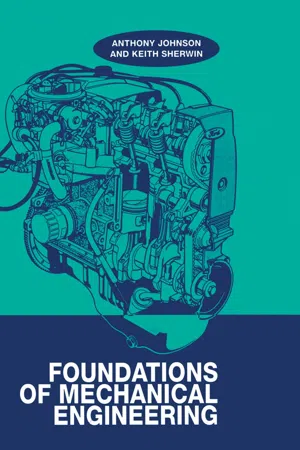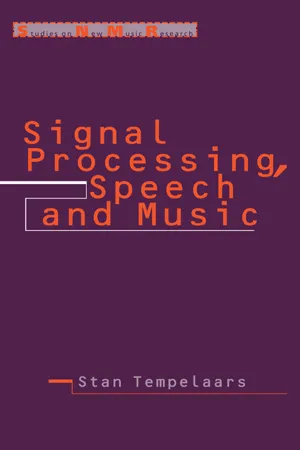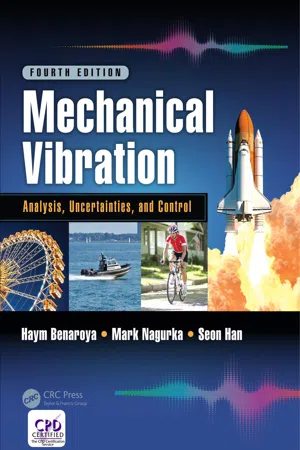Harmonic Motion
Harmonic motion refers to a type of periodic motion where the restoring force is directly proportional to the displacement from equilibrium. This results in a sinusoidal motion, such as the back-and-forth movement of a pendulum or a mass on a spring. The motion can be described using trigonometric functions and is characterized by its amplitude, frequency, and phase.
6 Key excerpts on "Harmonic Motion"
- eBook - ePub
- W. Bolton(Author)
- 2015(Publication Date)
- Routledge(Publisher)
...Chapter 28 Oscillations 28.1 Introduction This chapter is about the periodic motion of oscillating bodies. Any sort of motion which repeats itself in equal intervals of time is called periodic. The time between repetitions is called the periodic time and the motion occurring within one period is called a cycle (Figure 28.1) with the number of cycles per second termed the frequency. Since one cycle occurs in the periodic time T, the frequency is 1/ T. The unit of frequency is the hertz (Hz), with 1 Hz equal to one cycle per second. The amplitude A of an oscillation is the maximum displacement from the initial rest position, the range of displacement being thus ± A. Figure 28.1 A periodic oscillation The term free oscillation is used when an elastic system oscillates under the action of forces inherent in the system itself with there being no externally applied forces. The system will oscillate at, what is termed, a natural frequency, such frequencies being determined by the properties of the system. 28.2 Simple Harmonic Motion The simplest form of periodic motion is simple Harmonic Motion and the following demonstrates the characteristics of such motion. Consider a basic mechanical system of mass which when deflected from its rest position is restored to it by forces arising from elasticity in the system. Figure 28.2 shows such a system as a trolley tethered between two supports by springs. A trolley is used for the mass in order to minimise frictional effects. When the trolley, the mass of the system, is pulled to one side then one of the springs is compressed and the other stretched and this has the effect of providing a restoring force which is directed in such a direction as to endeavour to restore the trolley back to its rest position and is always proportional to its displacement from the rest position...
- eBook - ePub
- A. D. Johnson(Author)
- 2017(Publication Date)
- CRC Press(Publisher)
...Frequency is measured either in cycles per second (designated hertz or Hz) or in radians per second. Frequency in cycles per second, designated ‘ f ’, is easy to visualize and is used as a comparison of oscillation speed. Frequency measured in radians per second, designated ‘ ω ’, is used principally in calculation. Harmonic Motion The simplest form of periodic motion. It can also be described as motion which describes a sinusoidal path during its oscillation. Mass–elastic system An oscillating system in which there is no damping. It comprises an element of mass and a spring element. It should be noted that few systems in practice can be reduced to such an idealistic level. Natural frequency For a particular combination of mass and elasticity, this is a frequency at which the system prefers to vibrate. The lowest of these frequencies is termed the fundamental natural frequency and is the frequency at which the lowest resonance occurs. It is also termed ‘the first harmonic’. For any given system there usually occur higher natural frequencies which are termed second harmonic, third harmonic, etc. Oscillation The movement of a mass, to and fro, between two extreme points. Period The time taken to complete one cycle of oscillatory motion, designated τ and measured in seconds. Periodic motion Any motion which is repeated, where the repeat time is exactly the same, i.e. the period τ. The motion may vary from sinusoidal to being very complex, perhaps supporting numerous different but combined frequencies. Resonate/resonance A condition of an oscillating system where an excitation frequency coincides with a natural frequency. The results of such a combination may vary from uncomfortable vibrations to violent oscillation which is self-destructive. Vibration (see also oscillation) Motion to and fro, especially of parts of a fluid or an elastic solid whose equilibrium has been disturbed...
- eBook - ePub
- J. P. Den Hartog(Author)
- 2013(Publication Date)
- Dover Publications(Publisher)
...CHAPTER 1 KINEMATICS OF VIBRATION 1.1 Definitions. A vibration in its general sense is a periodic motion, i.e., a motion which repeats itself in all its particulars after a certain interval of time, called the period of the vibration and usually designated by the symbol T. A plot of the displacement x against the time t may be a curve of considerable complication. As an example, Fig. 1.1 a shows the motion curve observed on the bearing pedestal of a steam turbine. The simplest kind of periodic motion is a Harmonic Motion; in it the relation between x and t may be expressed by as shown in Fig. 1.1 b, representing the small oscillations of a simple pendulum. The maximum value of the displacement is x 0, called the amplitude of the vibration. F IG. 1.1. A periodic and a harmonic function, showing the period T and the amplitude x 0. The period T usually is measured in seconds; its reciprocal f = 1/ T is the frequency of the vibration, measured in cycles per second. In some publications this is abbreviated as cyps and pronounced as it is written. In the German literature cycles per second are generally called Hertz in honor of the first experimenter with radio waves (which are electric vibrations). In Eq. (1.1) there appears the symbol ω, which is known as the circular frequency and is measured in radians per second. This rather unfortunate name has become familiar on account of the properties of the vector representation, which will be discussed in the next section. The relations between ω, f, and T are as follows. From Eq. (1.1) and Fig. 1.1 b it is clear that a full cycle of the vibration takes place when ωt has passed through 360 deg. or 2 π radians. Then the sine function resumes its previous values. Thus, when ωt = 2 π, the time interval t is equal to the period T or. Since f is the reciprocal of T, For rotating machinery the frequency is often expressed in vibrations per minute, denoted as v.p.m. = 30 ω/π. F IG. 1.2...
- eBook - ePub
- Stan Tempelaars(Author)
- 2014(Publication Date)
- Routledge(Publisher)
...Such a system is called a harmonic oscillator. The following chapter is devoted to this. A tuning fork that is not struck too hard is an example of a ‘natural’ harmonic oscillator. 2. It is possible to lay a link between non-sinusoidal vibrations and sinusoidal vibrations. This important reduction of arbitrary vibrations to sinusoidal vibrations is called Fourier analysis and is dealt with in chapter 4. 3. With an important group of systems that are called linear systems, sinusoidal vibrations are given a sort of preference treatment in the sense that the sinusoidal shape in these systems is not affected. In chapter 5 attention is paid to this ‘sine in/sine out’-principle. D. Trigonometric functions Because sinusoidal signal functions are so important in the theory of vibrations, it is necessary to be familiar with the mathematical characteristics of the sine functions. The following summary gives the most important rules for our applications (see also Szabo et al. 1974). 1. Definitions Figure 2.6.7 Rectangular triangle. In fig.2.6.7 you see again the triangle with the original definition of the sine: If this proportion is known then all other possible proportions between the sides of the triangle are set. In principle we can limit ourselves thus to the sine. Still, it is sometimes easy to give a name to some of the other proportions as well. This has been done among others with the two proportions For broader definitions of cos and tan use is made, just as for the sine, of a circle with radius 1. Have a look at the figure to the right and compare the definitions with the previous one. 2. Special cases For certain values of α the values for sine, cos and tan can be derived from the geometric characteristics. Check for yourself: Figure 2.6.8 Definition sine, cosine and tangent. 3...
- eBook - ePub
- William Bolton(Author)
- 2012(Publication Date)
- Routledge(Publisher)
...The system will oscillate at, what is termed, a natural frequency, such frequencies being determined by the properties of the system. 3 Forced oscillations Oscillations which take place under the effect of externally applied periodic forces are called forced oscillations. Thus if the support of the spring system in Figure 6.1(a) was itself oscillating it would give forced oscillations of the spring system. 4 Damping Oscillating mechanical systems are all subject to damping due to energy being dissipated by friction and other resistances. With free oscillations, since no energy is externally supplied to the system when oscillating then the effect of energy being dissipated by damping is for the oscillations to die away with time. Thus if the simple pendulum in Figure 6.1(c) is set into free oscillation, the oscillation will gradually die away with time with the amplitude of the oscillation becoming progressively smaller. 6.2 Simple Harmonic Motion The simplest form of periodic motion is simple Harmonic Motion. Consider a basic mechanical system of mass which when deflected from its rest position is restored to it by forces arising from elasticity in the system. Figure 5.3 shows such a system as a trolley tethered between two supports by springs. A trolley is considered for the mass in order to effectively eliminate frictional effects. Figure 6.3 A basic mechanical system When the trolley, the mass of the system, is pulled to one side then one of the springs is compressed and the other stretched and this has the effect of providing a restoring force which is directed in such a direction as to endeavour to restore the trolley back to its original position. If the trolley is released from this deflected position, the restoring force causes the trolley to move back towards its original rest position and overshoot that position. The restoring force then reverses its direction to still be directed towards the rest position and so oscillations occur...
- eBook - ePub
Mechanical Vibration
Analysis, Uncertainties, and Control, Fourth Edition
- Haym Benaroya, Mark Nagurka, Seon Han(Authors)
- 2017(Publication Date)
- CRC Press(Publisher)
...The approximation 9 can be verified numerically and the angle beyond which the assumption breaks down can be identified. With this approximation, the equation of motion, Equation A.13, becomes (A. 15) d 2 θ d t 2 + θ = 0 which is an equation for a linear harmonic oscillator. Equation A.15 is valid only for small oscillations about the equilibrium position, θ = 0. To summarize, for small oscillations about the equilibrium, we set θ ≪ 1 and retain the first term in the Taylor series of the nonlinear function. This first term of the series is always linear. Some useful series about θ 0 = 0 are listed in Table A.1. The Taylor series centered at zero is also called a Maclaurin series. 10 Table A.1 Taylor Series Expansion about 0. A.4 Ordinary Differential Equations Any equation involving derivatives is called a diffe rential equation. If there is only one independent variable the equation is termed an ordinary diffe rential equation. If the dependent variable is a function of two or more parameters, for example time and spatial coordinate y (t, x), then the differential equation is called a partial differential equation. The study of vibration depends heavily on the solution of linear ordinary differential equations with time as the independent variable. A common form in vibration studies is a 2 ÿ (t) + a 1 y ˙ (t) + a 0 y (t) = f (A.16)subject to the initial conditions y (0) and y (0). The coefficients a 2, a 1, and a 0 are constants, 11 f (t) is a given function of time, and overdots denote differentiation with respect to time. If f (t) ≠ 0, the differential equation is called non ‐ homogeneous ; if f (t) = 0, the differential equation is called homogeneous. Equation A.16 is known as an initial ‐ value problem since its solution depends on the given initial values (or conditions) y (O) and y ˙ (0)...





